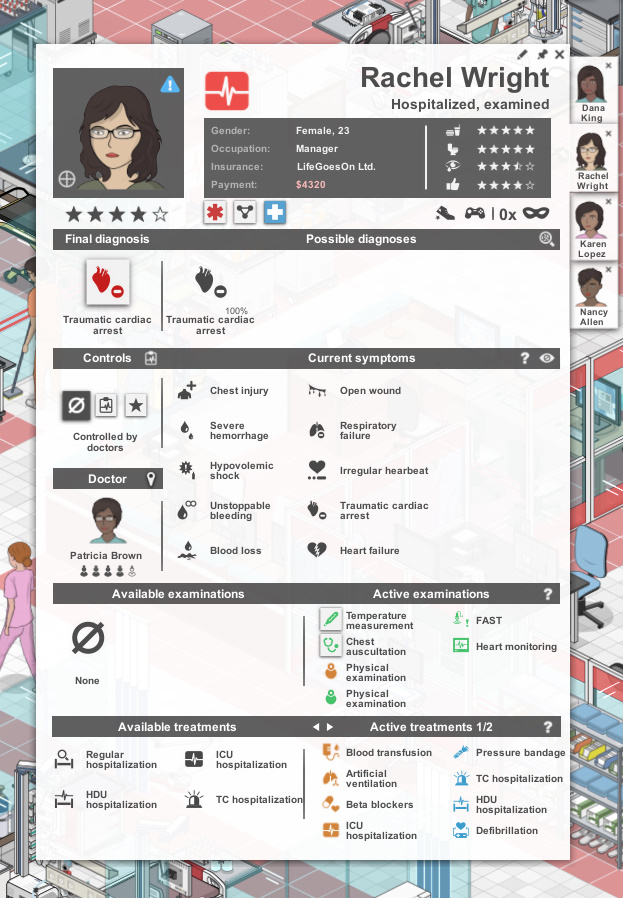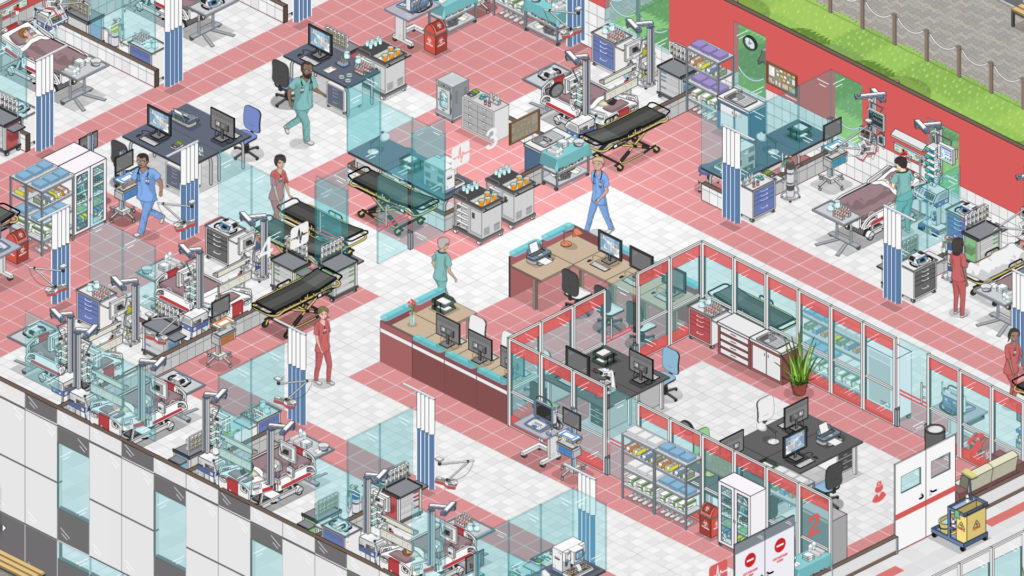In 1997 Bullfrog Productions released Theme Hospital, the second management game in the Theme series which started with the popular Theme Park in 1994. Featuring wacky humor and silly diseases alongside building freedom and an interesting simulation to optimize, it unwillingly set the standard for video game hospital management simulations, as much as Dungeon Keeper, released later the same year, would set the standard for the newfangled genre of evil dungeon management games and usher generations of copycats.
Since then, exactly three studios have tried to run the gauntlet, interestingly at 10 years intervals. DR Studios in 2007 with Hospital Tycoon, then in 2017 separately Two Point Studios (founded by ex-employees from Bullfrog Productions) with Two Point Hospital and Oxymoron Games with Project Hospital.
I reviewed Hospital Tycoon almost a decade ago [fr] and found it way inferior to Theme Hospital. Bland 3D graphics, a forgettable scenario, unwarranted Sims-like interactions and a simulation pretty much already decided for you made it a hard pass for me.
Two Point Hospital, played during a free period on the Steam platform, seems to me closer to the original to a fault. Without bringing anything really new to the table, it just felt like a slightly larger version of Theme Hospital. Which is probably perfect for anyone not having known the original, but left me unimpressed because I played Theme Hospital through and through.

However, Project Hospital really captured my attention. Instead of the tried and tired wacky hospital management simulation that the three previously mentioned games offer with varying degrees of success, this game went its own way with a bet on realism. This means all the illnesses are real, the symptoms to figure them out are real as well, and the treatments to cure them all exist. House watchers surely will recognize the infamous Lupus disease with its plethora of symptoms, each one insufficient to properly ensure such a rare diagnostic.
Because of the commitment to realism, the simulation got interestingly more complex. Procedures are closer to the real ones and consequently rooms require more critical pieces of equipment like defibrillators, bio-hazard trash bins or other laboratory fume hoods. In the same vein, hospitalized patients don’t just walk around anymore, they are properly carted around on stretchers by nurses between examination rooms and the different wards depending on the criticality of their condition.
With up to 9 different department sharing facilities (common room, bathroom, operating room) or not, there is always something to build, improve or optimize. The options for constructions and decorations are legions, and, icing on the cake, rooms aren’t defined by walls. This allows a layout flexibility that is crucially absent from the three other similar hospital management simulation video games. As long as the expected equipment for a given room is present in the room area, it is considered usable. This allows to put a nurse station smack dab in the middle of an ICU ward or an emergency bay for faster access to patients at risk of collapse. Or to divide a single janitor’s closet between two departments sharing a floor. Or to put a personal toilet in the X-Ray room to minimize the technician’s down time.

Sure, Project Hospital isn’t intentionally funny like Theme Hospital or the two other similar games, with no visual gags, silly diseases nor comedic PA messages. But as the simulation is more complex, it also can be unintentionally funny, like the wrong diagnoses from green doctors; or the “No Death” setting to prevent patients from ever dying in your hospital; or the very serious “Alcoholic” perk employees can have that will have them sometimes show up drunk at work.
Ultimately, Project Hospital is a pretty dense game that does a pretty good job at hand holding the player in the first steps. Familiar room-like blueprints, tutorial levels, pre-built campaign hospitals, the player is never dropped in an unfamiliar environment without a few pointers, although feedback still could be improved. For example some patients are shown as “Waiting” without precision what. In some cases, they will wait at an office that isn’t actually receiving patients without immediately setting off a notice. Since there are no real rooms, there aren’t clear patients queues either that would allow manual reordering like in Theme Hospital.
But I have been perfectly able to get over the few annoying points for the simple joy of playing a game that I didn’t feel having played already. Project Hospital is a fresh take on a video game genre that had became a monolith, and I’m here for that.


Mentions